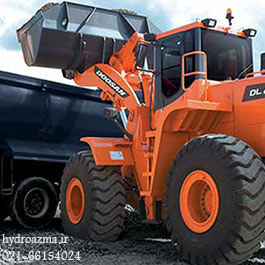Agriculture industry
Today, hydraulics play an important role in tractors and agricultural machinery. The word “hydro” is derived from a Greek word meaning “water” and “lake” meaning pipe, and the word hydraulic means water in a pipe.
From the beginning of 200 BC, humans understood the importance of hydraulics. For example, they knew that falling water from a great height had energy with it. For this reason, they used a blue wheel to convert potential energy into mechanical energy. With the advancement of science and the construction of piping networks, a pump was needed to transfer pressurized water from one place to another, which required a lot of energy to operate.
During this stage, some auxiliary devices such as control valves, seals, warehouses, etc. were invented. Today, hydraulics is considered the driving force of the industry.
Hydraulic system applications
One of the needs of all machines is to control and transmit power and movement. For this purpose, mainly mechanical methods are used. In mechanical systems, components such as cams, gears, gears, levers, clutches, etc. are used to transmit and control force and movement. Liquids are almost incompressible. This feature has led to the use of liquids as a suitable means of conversion and transfer of force and motion.
Today, in many industrial processes, power transmission is considered low cost and high accuracy. In this regard, the use of pressurized fluid in power transmission and control is expanding in all branches of industry. Industrial hydraulics is a topic that deals with practical methods of using pressurized liquids.
In hydraulic systems, there are fewer actuators than in mechanical systems, and linear or rotational movements with high power and proper control can be achieved anywhere. The hydraulic system is widely used in tractors and agricultural machinery due to the large increase it can cause during transmission.
Advantages of hydraulic systems
- Small dimensions
- Do not move under the load
- Ability to change the direction of movement
- Providing variable speeds
- Ease of converting rotational motion to reciprocating and vice versa
Disadvantages of hydraulic system
- Creating environmental pollution
- Possibility of oil leakage and possible fire
- The possibility of risk due to non-compliance with standards
- The possibility of personal injury if oil is spilled
- Dependence on quality and temperature in the hydraulic system
- Sensitivity to pollutants and dust
Applications of hydraulic system in agricultural machinery
- Blade behind tractor
- Bill Tractor
- Backhoe tractor loader
Early tractors lacked a hydraulic system, only pulling tools and not being able to lift them. But today’s tractors are equipped with a hydraulic system. Some applications of the hydraulic system are:
- Use in the tractor steering system for better tractor steering
- Lifting devices connected to the three-point connection of the tractor
- Hydraulic clutch engagement, differential lock and power axle
- Control of devices using hydraulic output
The components of the hydraulic system of tractors are: hydraulic cylinder, hydraulic pump, hydraulic oil filter, hydraulic oil tank, interface pipes, divider, control handles, pressure relief valves, hydraulic system connection arms, hydraulic outlet



Leave a Reply